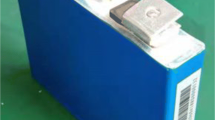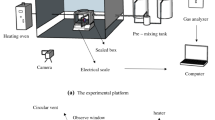Abstract
This paper takes NCM lithium-ion power battery as the research object. The internal reaction mechanism and heat generation are considered when the lithium-ion battery occurs thermal runaway (TR). The lithium-ion battery TR model under thermal-electrical coupling abuse is established by using temperature as the coupling factor. By comparing the heat source position, charging rate, and discharging rate of the lithium-ion battery, the effects of different working conditions on the internal parameters and TR characteristics are analyzed. The results show that the greater the charging rate, the higher the peak temperature of the TR; the TR trend of normal charging and overcharging is basically the same, but the overcharging voltage will continue to rise and exceed the rated voltage; different heat abuse positions have little effect on the overall temperature distribution. The above conclusions can provide theoretical basis for early warning and prevention of lithium-ion battery TR.






















Similar content being viewed by others
References
He XM, Feng XN, Ouyang MG (2016) Safety of Li-ion power battery system for vehicles[J]. Sci Technol Rev 34(6):32–38
Deng Y. (2021) Agglomeration of technology innovation network of new energy automobile industry based on IoT and artificial intelligence[J]. Journal of Ambient Intelligence and Humanized Computing, 1–17.
Feng X N, Ouyang M G, Liu X, et al. (2017) Thermal runaway mechanism of lithium ion battery for electric vehicles: a review[J]. Energy Storage Materials, S2405829716303464.
Richard MN, Dahn JR (1999) Accelerating rate calorimetry study on the thermal stability of lithium intercalated graphite in electrolyte. I. Experimental [J]. J Electrochemical Soc 146(6):2068–2077
Maleki H, Deng G, Anani A et al (1999) Thermal stability studies of Li-ion cells and components [J]. J Electrochem Soc 146(9):3224–3229
Ryou MH, Lee JN, Lee DJ et al (2012) Effects of lithium salts on thermal stabilities of lithium alkyl carbonates in SEI layer [J]. Electrochim Acta 83:259–263
Zhang Z, Fouchard D, Rea JR (1998) Differential scanning calorimetry material studies: implications for the safety of lithium-ion cells [J]. J Power Sources 70(1):16–20
C Lampe-Onnerud, Jie Shi, R Chamberlain, et al. (2001) Safety studies of Li-ion key components by ARC[C]// Conference on Applications & Advances. IEEE.
Yuan ZZ, Zhou ZT, Li WS (2002) The influence of electrolyte composition on the performance of SEI film of carbon anode in lithium ion battery[J]. Batteries 032(006):354–357
Chen YH, Tang ZY, He YB et al (2006) Analysis of explosion mechanism of lithium ion batteries[J]. Electrochemistry 12(3):266–269
Wang Y, Jiang J, Dahn JR (2007) The reactivity of delithiated Li(Ni1/3Co1/3Mn1/3)O2, Li(Ni0.8Co0.15Al0.05)O2 or LiCoO2 with non-aqueous electrolyte[J]. Electrochem Commun. 9:2534–2540
Kim H, Kong M, Kim K et al (2007) Effect of carbon coating on Li(Ni1/3Mn1/3Co1/3)O2 cathode material for lithium secondary batteries [J]. J Power Sources 171:917–921
Lu Z, Macneil DD, Dahn JR (2001) Layered Li[NixCo1-2xMnx]O2 cathode materials for lithium-ion batteries [J]. Electrochem Solid State Lett 12(4):200–203
Jiang J, Eberman KW, Krause LJ et al (2005) Reactivity of Liy[NixCo1–2xMnx]O2, (x=0.1, 0.2, 0.35, 0.45 and 0.5; y=0.3, 0.5) with non-aqueous solvents and electrolytes studied by ARC [J]. J Electrochem Soc 152(3):566–569
Wen J, Yu Y, Chen C (2012) A review on lithium-ion batteries safety issues: existing problems and possible solutions [J]. Mater Express 2(3):197–212
Vijayaraghavan V, Garg A, Liang G. (2017) Fracture mechanics modelling of lithium-ion batteries under pinch torsion test[J]. Measurement. 114.
Sahraei E, Bosco E, Dixon B et al (2016) Microscale failure mechanisms leading to internal short circuit in Li-ion batteries under complex loading scenarios[J]. J Power Sources 319:56–65
Wang M, Shi Y, Noelle DJ et al (2017) Effect of groove width of modified current collector on internal short circuit of abused lithium-ion battery[J]. J Phys D Appl Phys 50(42):425503
Wang M, Noelle DJ, Shi Y et al (2018) Effect of notch depth of modified current collector on internal-short-circuit mitigation for lithium-ion battery[J]. J Phys D Appl Phys 51(1):015502
Sheikh M, Elmarakbi A, Elkady M (2017) Thermal runaway detection of cylindrical 18650 lithium-ion battery under quasi-static loading conditions[J]. J Power Sources 370:61–70
Zhang MX, Feng XN, Ouyang MG et al (2015) Experiment and modeling of acupuncture thermal runaway of NCM lithium-ion power battery[J]. Automot Eng 7:743–750
Feng XN, Lu LG, Ouyang MG et al (2016) A 3D thermal runaway propagation model for a large format lithium ion battery module[J]. Energy 115(1):194–208
Spotnitz R, Franklin J (2003) Abuse behavior of high-power, lithium-ion cells [J]. Power Sour 113(1):81–100
Larsson F, Mellander BE (2014) Abuse by external heating, overcharge and short circuiting of commercial lithium-ion battery cells[J]. J Electrochem Soc 161(10):A1611–A1617
Conte FV, Gollob P, Lacher H (2009) Safety in the battery design: the short circuit[J]. World Electric Veh J 3:1–8
Zhao R, Liu J, Gu J (2016) Simulation and experimental study on lithium ion battery short circuit[J]. Appl Energy 173:29–39
Erol S, Orazem ME, Muller RP (2014) Influence of overcharge and over-discharge on the impedance response of LiCoO2|C batteries[J]. J Power Sour 270(15):92–100
Leising RA, Palazzo MJ, Takeuchi ES et al (2001) Abuse testing of lithium-ion batteries: Characterization of the overcharge reaction of LiCoO2/graphite cells[J]. J Electrochem Soc 148(8):A838–A844
** P, Wang QS, Huang PF et al (2015) Study of the fire behavior of high-energy lithium-ion batteries with full-scale burning test[J]. J Power Sour 285:80–89
Taheri P, Hsieh S, Bahrami M (2011) Investigating electrical contact resistance losses in lithium-ion battery assemblies for hybrid and electric vehicles[J]. J Power Sour 196(15):6525–6533
Tong W, Somasundaram K, Birgersson E et al (2015) Numerical investigation of water cooling for a lithium-ion bipolar battery pack [J]. Int J Therm Sci 94:259–269
Han B, Liu F, Li M et al (2021) Research on electric vehicle thermal management system with coupled temperature regulation between crew cabin and power battery pack[J]. Proc Inst Mech Eng Part D J Automob Eng 235(10–11):095440702199658
Newman BernardiPawlikowski (1985) A general energy-balance for battery systems[J]. J electrochem Soc 132(1):5–12
A Ríos-Alborés, J Rodríguez. (2019) Single particle models for the numerical simulation of lithium-ion cells[M]. Advances on Links Between Mathematics and Industry. 91.
Funding
This work was supported by Foundation of State Key Laboratory of Automotive Simulation and Control (20180103).
Author information
Authors and Affiliations
Corresponding author
Additional information
Publisher's note
Springer Nature remains neutral with regard to jurisdictional claims in published maps and institutional affiliations.
Rights and permissions
Springer Nature or its licensor holds exclusive rights to this article under a publishing agreement with the author(s) or other rightsholder(s); author self-archiving of the accepted manuscript version of this article is solely governed by the terms of such publishing agreement and applicable law.
About this article
Cite this article
Xu, X., Sun, X., Zhao, L. et al. Research on thermal runaway characteristics of NCM lithium-ion battery under thermal-electrical coupling abuse. Ionics 28, 5449–5467 (2022). https://doi.org/10.1007/s11581-022-04730-0
Received:
Revised:
Accepted:
Published:
Issue Date:
DOI: https://doi.org/10.1007/s11581-022-04730-0




